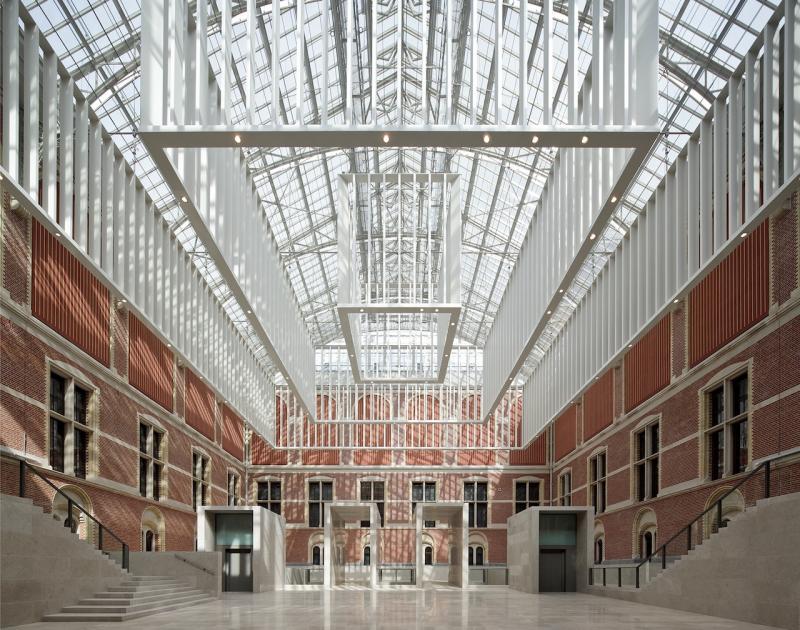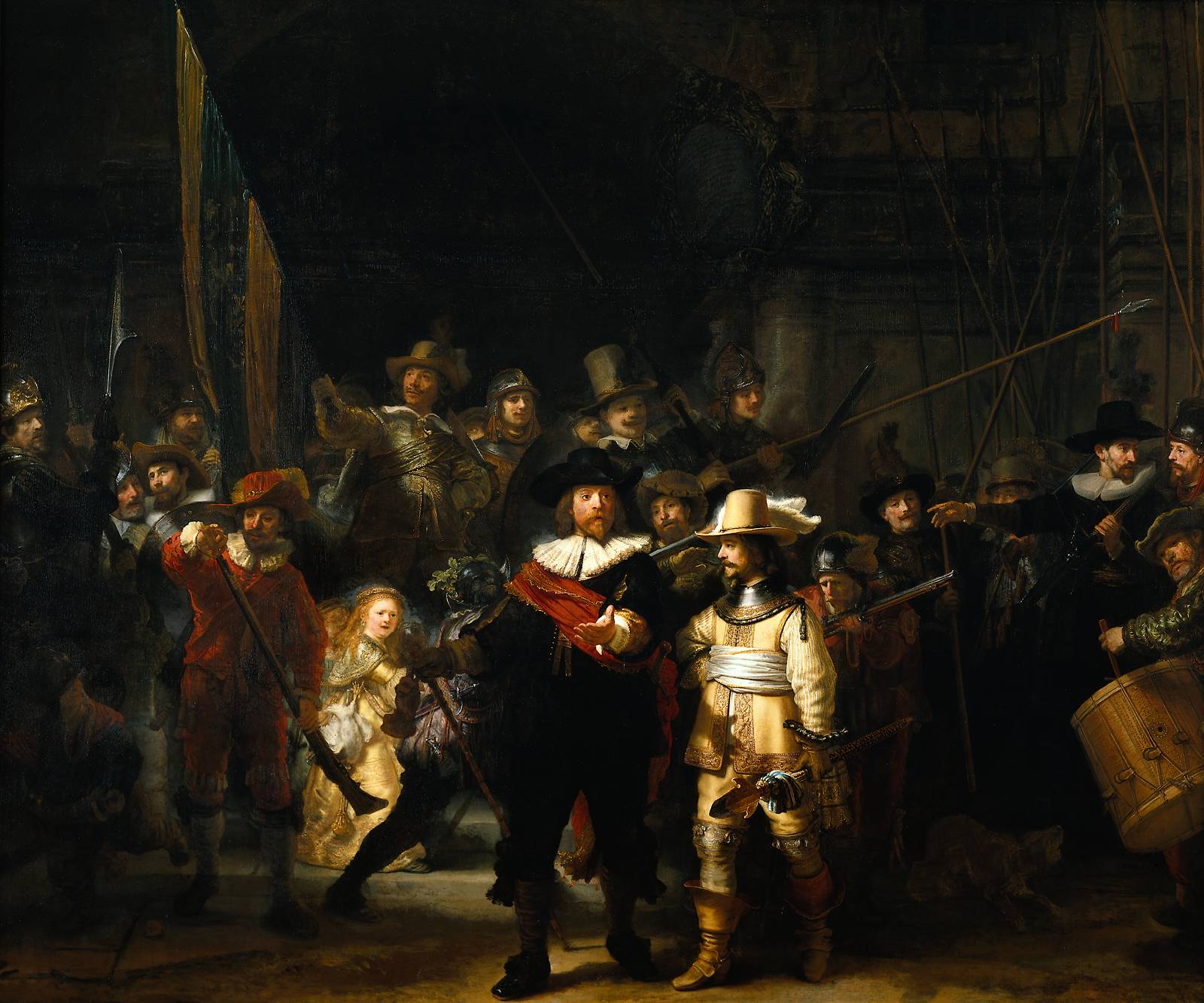theartsdesk in Amsterdam: Reopening of the Rijksmuseum | reviews, news & interviews
theartsdesk in Amsterdam: Reopening of the Rijksmuseum
theartsdesk in Amsterdam: Reopening of the Rijksmuseum
A very bold but beautifully sympathetic restoration for Holland's national museum

The Rijksmuseum is reopening after 10 years. What took it so long? Escalating costs, contractual problems, a protracted battle with the cycling lobby (this is Amsterdam, after all). I’m sure there’s more, but one whole decade’s worth? It’s a long time to go without a national museum that represents the best of Dutch art to the Dutch people, and to the world.
It’s easy to forget what a spectacular Medievalist fantasy the building actually is
But it’s all OK now. It’s been worth the wait. In fact, the improvement is staggering. The crepuscular gloom has been lifted and light has flooded in. You can, wow, actually see stuff. You can see and you can breathe. It feels like all the windows of a neglected, musty old stately home have been flung open and now the treasures within each room are lovingly illuminated. Hurrah.
At the heart of the building is the vast glass-ceilinged atrium: airy, bright and very modern. So it’s easy to forget what a spectacular Medievalist fantasy the building actually is, at least when you first step inside. It was designed in the 1880s by Pierre Cuypers, who also built Amsterdam Central Station. In the old days, you’d almost expect a train to come rushing through its central courtyard. But thankfully, this isn’t the wrecking Sixties, so a respect for the integrity of the original design has ensured that Cuypers’ Gothic decorative scheme has been retained by architects Cruz and Ortiz. The huge stained glass windows (pictured below) and the walls of the corridors that have been decorated with figures in Medieval garb emerge in all their spruced-up glory.

Except for a new “Hall of Honour”, where, organised by artist, you’ll find the great painters of the 17th-century Golden Age – Vermeer, Rembrandt, Steen, de Hooch, Ruisdael – the collection has been mixed up to great effect.
Sculpture sits easily with painting, and painting with the decorative and applied arts: furniture, ceramics, including the most elaborate Delftware you’ve ever seen, firing cannons, model sailing vessels, elaborate dolls houses of vast magnitude (not for children but for the amusement of wealthy ladies). There's a wooden box from the 17th century that looks like an ordinary humidor but with silver pouches for cuts of opium, and, on the top floor where the 20th century awaits you, a collaborationist Nazi chess set with pieces shaped like tanks, infantrymen and bomber planes. Next to the Mondrians and Van Doesburgs, you'll even find a 1917 Bantam airplane, built by aviation design pioneer Frits Koolhoven
It’s the chronology that matters, not classification. It’s history told through an amazing national collection. For instance, a wonderfully experimental, chiaroscuro self-portrait by Rembrandt aged 22, hangs in a room containing an ebony cabinet exquisitely inlaid with mother-of-pearl. It was made by celebrated cabinet-maker Herman Doomer, a friend to the artist who also made Rembrandt’s frames.
 Every bit of this is irresistible, though you can’t deny that the illustrious Hall of Honour – cheesily named, perhaps, but, heck, it really is a roll call – is the highlight. At one end of this corridor you’ll eventually find Rembrandt’s The Night Watch, 1642 (pictured above). It’s the only work in the collection that’s remained in the same place. And it seems that you can actually see it clearly for the first time (though my memory may be playing tricks, I remember the location as far gloomier). The colour and the detail are something you can never appreciate in a reproduction. Just who is that second little girl hidden behind the one facing us with the fleshy features of Saskia? The painting is even more mysterious seen in the flesh.
Every bit of this is irresistible, though you can’t deny that the illustrious Hall of Honour – cheesily named, perhaps, but, heck, it really is a roll call – is the highlight. At one end of this corridor you’ll eventually find Rembrandt’s The Night Watch, 1642 (pictured above). It’s the only work in the collection that’s remained in the same place. And it seems that you can actually see it clearly for the first time (though my memory may be playing tricks, I remember the location as far gloomier). The colour and the detail are something you can never appreciate in a reproduction. Just who is that second little girl hidden behind the one facing us with the fleshy features of Saskia? The painting is even more mysterious seen in the flesh.
It’s not just the Rijksmuseum that’s undergone a spactacular transformation. Next door you’ll find the Stediljk, which is dedicated to modern and contemporary art. It reopened last year with a brand new wing and a roof that resembles a bathtub (it’s known affectionately as “the bathtub”). And next month it’s the turn of the wonderful Van Gogh Museum, which, fortunately, only had to shut its doors for six months to undergo comparatively minor renovation work. It’s time to book that trip to Amsterdam.
Explore topics
Share this article
The future of Arts Journalism
You can stop theartsdesk.com closing!
We urgently need financing to survive. Our fundraising drive has thus far raised £49,000 but we need to reach £100,000 or we will be forced to close. Please contribute here: https://gofund.me/c3f6033d
And if you can forward this information to anyone who might assist, we’d be grateful.

Subscribe to theartsdesk.com
Thank you for continuing to read our work on theartsdesk.com. For unlimited access to every article in its entirety, including our archive of more than 15,000 pieces, we're asking for £5 per month or £40 per year. We feel it's a very good deal, and hope you do too.
To take a subscription now simply click here.
And if you're looking for that extra gift for a friend or family member, why not treat them to a theartsdesk.com gift subscription?
more Visual arts
 'We are bowled over!' Thank you for your messages of love and support
Much-appreciated words of commendation from readers and the cultural community
'We are bowled over!' Thank you for your messages of love and support
Much-appreciated words of commendation from readers and the cultural community
 Lee Miller, Tate Britain review - an extraordinary career that remains an enigma
Fashion photographer, artist or war reporter; will the real Lee Miller please step forward?
Lee Miller, Tate Britain review - an extraordinary career that remains an enigma
Fashion photographer, artist or war reporter; will the real Lee Miller please step forward?
 Kerry James Marshall: The Histories, Royal Academy review - a triumphant celebration of blackness
Room after room of glorious paintings
Kerry James Marshall: The Histories, Royal Academy review - a triumphant celebration of blackness
Room after room of glorious paintings
 Folkestone Triennial 2025 - landscape, seascape, art lovers' escape
Locally rooted festival brings home many but not all global concerns
Folkestone Triennial 2025 - landscape, seascape, art lovers' escape
Locally rooted festival brings home many but not all global concerns
 Sir Brian Clarke (1953-2025) - a personal tribute
Remembering an artist with a gift for the transcendent
Sir Brian Clarke (1953-2025) - a personal tribute
Remembering an artist with a gift for the transcendent
 Emily Kam Kngwarray, Tate Modern review - glimpses of another world
Pictures that are an affirmation of belonging
Emily Kam Kngwarray, Tate Modern review - glimpses of another world
Pictures that are an affirmation of belonging
 Kiefer / Van Gogh, Royal Academy review - a pairing of opposites
Small scale intensity meets large scale melodrama
Kiefer / Van Gogh, Royal Academy review - a pairing of opposites
Small scale intensity meets large scale melodrama
 Jenny Saville: The Anatomy of Painting, National Portrait Gallery review - a protégé losing her way
A brilliant painter in search of a worthwhile subject
Jenny Saville: The Anatomy of Painting, National Portrait Gallery review - a protégé losing her way
A brilliant painter in search of a worthwhile subject
 Abstract Erotic, Courtauld Gallery review - sculpture that is sensuous, funny and subversive
Testing the boundaries of good taste, and winning
Abstract Erotic, Courtauld Gallery review - sculpture that is sensuous, funny and subversive
Testing the boundaries of good taste, and winning
 Edward Burra, Tate Britain review - watercolour made mainstream
Social satire with a nasty bite
Edward Burra, Tate Britain review - watercolour made mainstream
Social satire with a nasty bite
 Ithell Colquhoun, Tate Britain review - revelations of a weird and wonderful world
Emanations from the unconscious
Ithell Colquhoun, Tate Britain review - revelations of a weird and wonderful world
Emanations from the unconscious
 Rachel Jones: Gated Canyons, Dulwich Picture Gallery review - teeth with a real bite
Mouths have never looked so good
Rachel Jones: Gated Canyons, Dulwich Picture Gallery review - teeth with a real bite
Mouths have never looked so good

Add comment